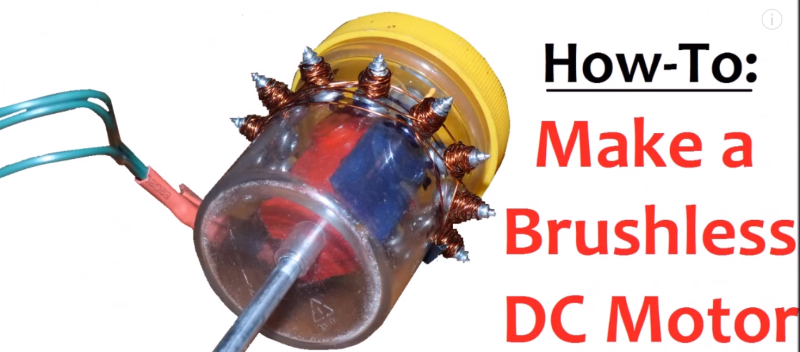Think you’ve got what it takes to build a homebrew brushless motor? As [JaycubL] shows us, it turns out that a bldc motor may be living in pieces right under your nose, in scraps that so many of us would otherwise toss aside. To get our heads turning, [JaycubL] takes us into the theory of brushless DC motors operate. He then builds a homebrew brushless motor using screws, a plastic container, a few bearings, a metal rod, some magnets, and a dab of epoxy. Finally, he gives it a whirl with an off-the-shelf motor controller.
This isn’t [JaycubL’s] first dive into homebrew brushless motors. For the curious, he’s also assembled a fully-functional brushless outrunner motor with a paint can housing.
Sure, understanding the principles is one thing, but being able to take the leap into the real world and find the functional beginnings of a motor from your scrap bin is an entirely different story! [JaycubL’s], dare we say, finesse of understanding the principles behind motor design makes us wonder: how many other functional higher-level electrical and mechanical components can we bootstrap from bitter scrap? To get you started, we’ll point you in the direction of this CNC router that’s just a few steps away from one trip to the hardware store.
Thanks for the tip, [John]!
















Hmm, that’s useful. Is there a “BLDC driver from scraps” somewhere?
These Microchip appnotes may help you: http://ww1.microchip.com/downloads/en/AppNotes/00885a.pdf and http://ww1.microchip.com/downloads/en/AppNotes/00857B.pdf.
Epic hack.
Hmm, good place to ask I suppose. Why are they called brushless DC motors when they are clearly variable frequency three phase AC motors. I have never got my head round that at all.
If it’s a brushless motor with the drive electronics built in and no user intervention required other than a DC power source on the external wires (think computer fan, for example) then it’s a “DC motor”. Calling it a brushless motor is important, since recognizing that it’s brushless shows that there are significant differences in the reliability and maintenance of the motor (since brushes suck, basically.)
The brushless bit I understand, it’s the DC bit that makes no sense. All these things now work the same way, take AC, do soemthing with it to make it DC,(store it maybe) do something with it to make it AC again and feed it to a motor. That is true whether it is a VFD and an AC motor or a USC and a DC motor. It was probably the same guy that decided that daughter boards were now called shields
That should have said ESC not USC, can some helpful bod edit it please.
I think it’s because of the way they evolved from brushed DC motors. They also have different stator geometries from sinusoidal AC motors and so have trapezoidal back EMF (which makes the motor more efficient when used with a basic 3-state, 6-step trapezoidal controller.) Interestingly the brushed DC motor is wound the same way, as a mechanical commutator provides similar waveforms to a trapezoidal bldc controller. Otherwise they are indeed a type of synchronous AC motor (as opposed to induction)
The real difference is in the winding and drive electronics. BLDC are supposed to have some winding designed for trapezoidal commuation (so the DC level stays constant and the windings switch). This can be implemented with simple electronics but has high torque ripple at the switching points. Three phase AC permanent magnet motors have sinusoidal drive. Again, some winding optimization is done to improve that mechanism. I’ve driven BLDC with PMAC drives and vice versa, so it’s really a gray area and more depends on where the company or person that’s discussing it came from originally.. The only other thing I can think of that might differentiate is that BLDC tends to be low voltage (60V and less) and PMAC tends to be line voltage (rectified 230V and up, sometimes 120V).
The difference between perfectly sinusoidal and trapezoidal is a sliding one, it’s impossible to have a motor purely trapezoidal or purely sinusoidal (but sinusoidal does come close).
As for the naming, it was picked up by designers who would see a simple drop-in replacement for their current brushed designs, with emphasis on the new, fancy and efficient “brushless” part. Funnily, this is the part that makes it to the marketing departments also, so it definitely sells.
So basically it’s a marketing thing done to confuse technical people so that the people whose shirt sleeves are slightly too long to show off their cuff links get some more abbreviations to use in their work speak.
Well, in the ideal design case, the drive of the commutator on the BLDC motor is DC assuming you stay at one state. This doesn’t do reality much justice, but given the complexity of spectral mathematics, it’s an understandable assumption someone would make.
A very useful and well done video to explain how the BLDC motors work. I will show this to kids I’m trying to tach electronics to. Thanks :)
Good project for a high school tech class.
This paper is helpful in correctly understanding the differences between the various types of motors.
P. Pillay & R. Krishnan, ‘Application Characteristics of Permanent Magnet Synchronous and Brushless dc Motors for Servo Drives’.
http://colgate.mech.northwestern.edu/Haptics_Course/Suggested_Readings/Pillay_1991_PermanentMagnetSynchronousAndBrushlessDCMotors.pdf